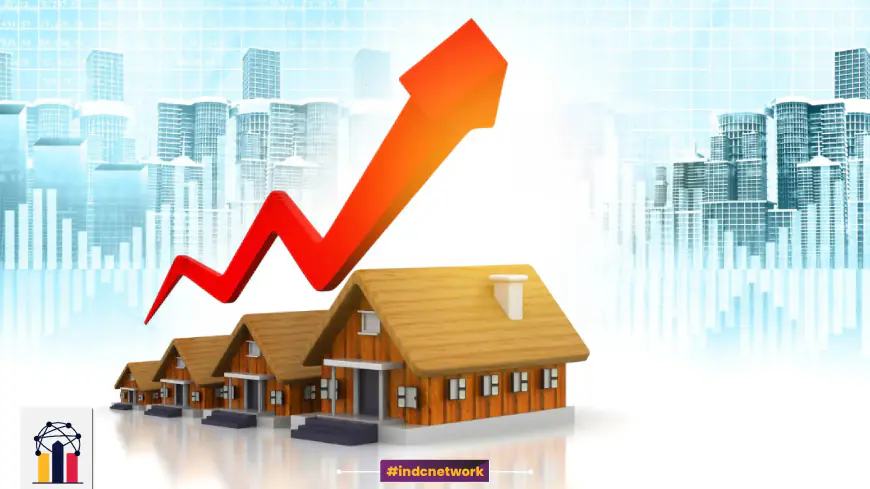Decoding the Enigma of the Real Estate Market: What Lies Beneath the Surface of Property Trends
Explore the multifaceted world of the real estate market, unraveling the factors influencing property trends and market dynamics. This in-depth analysis covers historical perspectives, current market conditions, emerging trends, and future forecasts, revealing the underlying forces driving the real estate industry

INDC Network : Business : Decoding the Enigma of the Real Estate Market: What Lies Beneath the Surface of Property Trends
The real estate market, a critical pillar of the global economy, is often seen as a complex and enigmatic domain. For many, it represents a blend of investment opportunity and economic indicator, shaping and reflecting broader economic conditions. Yet, beneath the surface of market trends and property values lies a web of factors influencing the sector's dynamics. This article delves into the intricacies of the real estate market, offering insights into its historical evolution, current conditions, emerging trends, and future prospects.
Historical Evolution of the Real Estate Market : Understanding the present state of the real estate market requires a look back at its historical evolution. The market has undergone significant transformations influenced by economic cycles, technological advancements, and changing societal needs.
1. Early Real Estate Practices:
- Ancient Real Estate: The concept of property ownership dates back to ancient civilizations. In Rome and Greece, land ownership was a symbol of wealth and power. Early real estate transactions were often recorded on clay tablets and other rudimentary documentation.
- Feudal Systems: In medieval Europe, land was held under feudal systems, where lords granted land use rights to vassals in exchange for services. This system laid the groundwork for modern property rights and ownership structures.
2. The Industrial Revolution:
- Urbanization: The Industrial Revolution in the 18th and 19th centuries led to mass urbanization and significant shifts in real estate dynamics. Rapid industrialization and migration to cities spurred demand for residential and commercial properties.
- Modern Real Estate Practices: This era saw the development of modern real estate practices, including property development, zoning laws, and the establishment of real estate agencies.
3. Post-War Boom:
- Housing Market Growth: The post-World War II era witnessed a housing boom, driven by economic prosperity, population growth, and suburban expansion. The rise of the middle class and increased access to mortgage financing fueled residential property demand.
- Commercial Real Estate: The growth of the commercial real estate sector mirrored residential expansion, with the development of office spaces, retail centers, and industrial properties.
4. The Digital Age:
- Technology Integration: The late 20th and early 21st centuries saw the integration of technology into real estate practices. Online property listings, virtual tours, and data analytics transformed how properties are bought, sold, and managed.
- Market Volatility: The digital age also introduced new dynamics, such as market volatility and the impact of global financial crises on real estate values.
Current State of the Real Estate Market : The real estate market today is a dynamic and multifaceted sector influenced by a range of factors, including economic conditions, demographic trends, and technological advancements.
1. Economic Influences:
- Interest Rates: Interest rates play a critical role in shaping real estate markets. Low interest rates typically encourage borrowing and stimulate property purchases, while high rates can dampen demand.
- Economic Cycles: Real estate markets are cyclical, with periods of boom and bust influenced by broader economic conditions. Recessions can lead to declining property values, while economic expansions often drive up prices.
2. Demographic Trends:
- Urbanization: Urbanization continues to drive demand for residential and commercial properties in metropolitan areas. As more people move to cities, there is an increasing need for housing, office space, and infrastructure.
- Aging Population: The aging population is influencing real estate trends, with growing demand for retirement communities, accessible housing, and healthcare facilities.
3. Technological Advancements:
- PropTech: The rise of property technology (PropTech) is transforming the real estate industry. Innovations such as blockchain for property transactions, AI-driven property valuation, and smart home technologies are reshaping the market.
- Data Analytics: Data analytics is increasingly used to inform investment decisions, optimize property management, and predict market trends. Big data provides valuable insights into buyer behavior, market demand, and investment opportunities.
4. Market Segments:
- Residential Market: The residential real estate market encompasses single-family homes, apartments, and condominiums. Trends in this segment include fluctuating home prices, varying demand across regions, and shifts in buyer preferences.
- Commercial Market: The commercial real estate market includes office spaces, retail properties, and industrial facilities. Key trends include changes in office space usage due to remote work, the growth of e-commerce impacting retail properties, and the demand for logistics and warehousing facilities.
Emerging Trends in Real Estate : As the real estate market evolves, several emerging trends are shaping its future direction:
1. Sustainability and Green Building:
- Environmental Impact: There is a growing emphasis on sustainability and green building practices. Energy-efficient buildings, sustainable materials, and eco-friendly designs are becoming standard in new developments.
- Green Certifications: Certifications such as LEED (Leadership in Energy and Environmental Design) are increasingly sought after by developers and investors, reflecting a commitment to environmental responsibility.
2. Smart Cities and Infrastructure:
- Urban Innovation: The concept of smart cities integrates technology into urban planning and infrastructure. Innovations such as smart traffic management, energy-efficient buildings, and connected public services are enhancing urban living.
- Infrastructure Investments: Investments in infrastructure, including transportation, utilities, and connectivity, play a crucial role in shaping real estate markets and improving property values.
3. Remote Work and Flexible Spaces:
- Office Space Trends: The rise of remote work and hybrid work models is transforming office space requirements. Companies are rethinking office layouts, with a focus on flexible workspaces and collaborative environments.
- Co-Living and Co-Working: Co-living and co-working spaces are gaining popularity, providing flexible and affordable options for individuals and businesses. These models offer shared resources and community-driven environments.
4. Global Investment and International Markets:
- Cross-Border Investment: Globalization has led to increased cross-border investment in real estate. Investors are exploring opportunities in emerging markets and diversifying their portfolios across different regions.
- Economic Uncertainty: Global economic uncertainty, geopolitical tensions, and currency fluctuations impact international real estate investments, influencing investor decisions and market dynamics.
Challenges Facing the Real Estate Market : Despite its growth and evolution, the real estate market faces several challenges that impact its stability and sustainability:
1. Affordability and Housing Shortages:
- Rising Prices: In many regions, rising property prices and rental costs are outpacing wage growth, leading to affordability issues for buyers and renters.
- Housing Shortages: Housing shortages, particularly in urban areas, contribute to increased competition and higher prices. Addressing this issue requires coordinated efforts in policy, planning, and development.
2. Regulatory and Legal Complexities:
- Zoning and Land Use: Navigating zoning regulations, land use policies, and building codes can be complex and time-consuming for developers and investors. Regulatory changes can impact project feasibility and profitability.
- Legal Disputes: Legal disputes related to property ownership, lease agreements, and contractual obligations can arise, requiring careful management and resolution.
3. Market Volatility and Economic Fluctuations:
- Economic Cycles: Real estate markets are influenced by economic cycles, with periods of volatility and uncertainty affecting property values and investment returns.
- Financial Crises: Financial crises, such as the 2008 housing bubble, can lead to significant market disruptions and impact investor confidence.
4. Technological Disruption and Cybersecurity:
- Tech Integration: While technology offers opportunities for innovation, it also presents challenges related to data security and cybersecurity. Protecting sensitive information and ensuring secure transactions are critical for maintaining market integrity.
The Future of the Real Estate Market : As the real estate market continues to evolve, several factors will shape its future trajectory:
1. Technological Innovation: Digital Transformation: The continued integration of technology into real estate practices will drive efficiency, transparency, and innovation. Advances in AI, blockchain, and IoT will play a significant role in shaping the future of the market.
2. Sustainable Development: Green Initiatives: The focus on sustainability and green building practices will become increasingly important. Developers, investors, and policymakers will prioritize environmental responsibility and energy efficiency.
3. Demographic Shifts: Changing Preferences: Demographic shifts, including the preferences of millennials and Gen Z, will influence housing demand and property types. Factors such as lifestyle choices, mobility, and family dynamics will impact market trends.
4. Globalization and Cross-Border Investments: International Opportunities: Globalization will continue to drive cross-border investments and international market exploration. Investors will seek opportunities in emerging markets and diverse geographic regions.
Conclusion : The real estate market is a multifaceted and dynamic sector that plays a crucial role in the global economy. From its historical roots to its current state and future prospects, the market is influenced by a complex interplay of economic, demographic, and technological factors. Understanding the underlying forces shaping the real estate market provides valuable insights into its trends, challenges, and opportunities.
As we move forward, the real estate market will continue to evolve, driven by technological advancements, sustainability initiatives, and shifting demographic trends. By decoding the enigma of the real estate market, investors, developers, and stakeholders can navigate its complexities and make informed decisions that drive growth and success.
What's Your Reaction?














































































































































































